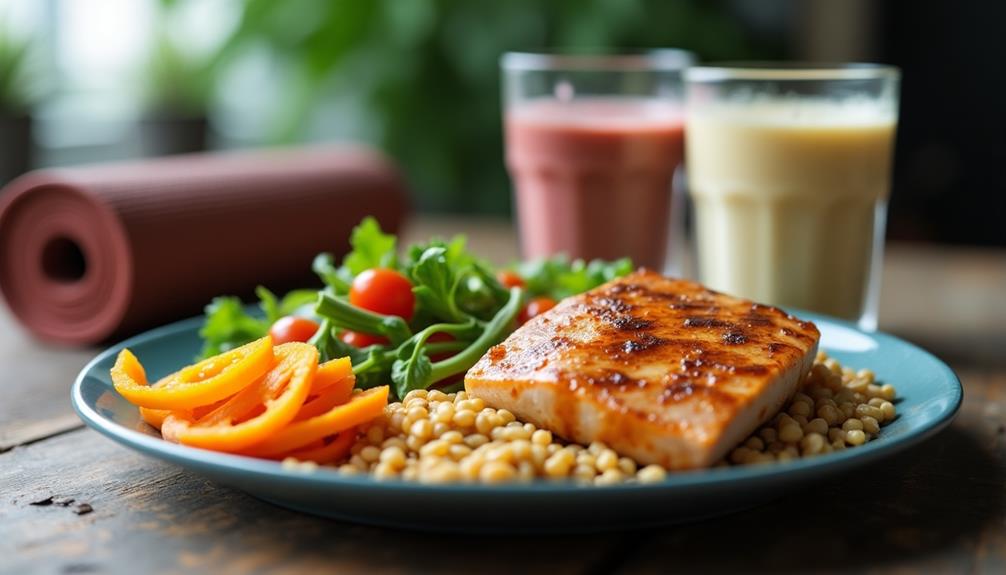To reduce DOMS after hypertrophy workouts, start with hydration; drink water to transport nutrients and flush toxins. Incorporate active recovery, such as low-intensity exercises and foam rolling, to improve blood flow. Nutrition is key, so prioritize protein and antioxidant-rich foods post-workout. Get adequate sleep to aid recovery, and consider cold therapy, like ice packs, to decrease inflammation. Finally, gradually increase workout intensity to allow your muscles to adapt. These strategies can notably alleviate soreness, helping you stay on track with your training goals. Explore further for practical methods to implement these tips effectively.
Core Insights
- Stay well-hydrated by drinking water before, during, and after workouts to minimize DOMS and support muscle recovery.
- Incorporate active recovery techniques like low-intensity exercises, foam rolling, and stretching to enhance blood flow and reduce soreness.
- Prioritize post-workout nutrition with protein, antioxidants, and healthy fats to support muscle repair and reduce inflammation.
- Gradually increase workout intensity to allow muscles to adapt and prevent excessive soreness from overexertion.
- Consider using cold therapy, such as ice packs or cold showers, to significantly reduce muscle soreness and inflammation after workouts.
Stay Hydrated

During your hypertrophy workouts, staying hydrated is essential for minimizing delayed onset muscle soreness (DOMS). When you're well-hydrated, your muscles recover faster and function at their best. Water helps transport nutrients to your muscles and flushes out toxins that can contribute to soreness. Aim to drink water before, during, and after your workouts to maintain hydration levels. For intense workouts in hot conditions, salt pills for hydration can help replenish electrolytes and maintain proper fluid balance in your body.
To gauge your hydration status, pay attention to your urine color. Light yellow indicates good hydration, while dark yellow suggests you need more fluids. If you're sweating heavily during your workouts, consider adding electrolytes to your hydration routine. This can further support muscle function and recovery. By prioritizing hydration, you'll not only reduce DOMS but also enhance your overall performance and well-being during your hypertrophy training.
Incorporate Active Recovery

Incorporating active recovery into your routine can greatly help in reducing DOMS after hypertrophy workouts. Active recovery involves engaging in low-intensity exercises that promote blood flow without straining your muscles. Think light jogging, walking, or gentle cycling. These activities can aid in flushing out lactic acid and delivering nutrients to your muscles, speeding up recovery. Foam rollers can also be an effective tool for myofascial release, helping to alleviate muscle soreness and improve flexibility during your recovery sessions.
Aim for about 20-30 minutes of active recovery on your rest days. Stretching is also beneficial; it helps maintain flexibility while easing muscle tension. Additionally, consider activities like yoga or swimming, as they provide a full-body experience without the intensity of your regular workouts. By prioritizing active recovery, you'll feel better prepared for your next training session and minimize muscle soreness.
Prioritize Nutrition

Prioritizing nutrition is essential for reducing DOMS after hypertrophy workouts. What you eat plays a pivotal role in how your muscles recover. To maximize recovery, consider these key nutritional tips:
- Protein Intake: Aim for a protein-rich meal or snack within 30 minutes post-workout to kickstart muscle repair.
- Hydration: Drink plenty of water before, during, and after workouts to prevent dehydration, which can worsen soreness.
- Antioxidant-Rich Foods: Incorporate fruits and vegetables, like berries and leafy greens, to help reduce inflammation.
- Healthy Fats: Include sources like avocados or nuts in your diet to support overall recovery and joint health.
To further support muscle recovery, consider incorporating fast-acting carbohydrates into your post-workout nutrition plan. These can help replenish glycogen stores quickly and aid in overall recovery.
Use Foam Rollers

After you've fueled your body with the right nutrients, using foam rollers can greatly enhance your recovery and reduce DOMS. Foam rolling works by applying pressure to your muscles, which helps release tension and improve blood flow. This can speed up the recovery process, making you feel less sore after intense workouts.
To get started, choose a foam roller that suits your needs. Begin with larger muscle groups like your quads, hamstrings, and back. Roll slowly over each area, pausing on tight spots for 20 to 30 seconds. This targeted pressure can help break down knots and improve flexibility. Aim to foam roll after your workouts and even on rest days for best results. Your muscles will thank you!
Get Adequate Sleep

- Stick to a Schedule: Go to bed and wake up at the same time every day to regulate your body's internal clock.
- Create a Relaxing Environment: Keep your bedroom dark, cool, and quiet to promote restful sleep.
- Limit Screen Time: Avoid screens at least an hour before bed to reduce blue light exposure.
- Practice Relaxation Techniques: Try deep breathing or meditation to wind down before sleep.
Prioritizing sleep will help you recover faster and minimize DOMS.
Try Cold Therapy

While many people underestimate the power of cold therapy, incorporating it into your post-workout routine can significantly reduce delayed onset muscle soreness (DOMS). Cold therapy can come in various forms, such as ice packs, cold baths, or even cryotherapy.
To get started, apply an ice pack to the sore areas for 15-20 minutes right after your workout. This helps constrict blood vessels and reduce inflammation. Alternatively, consider a cold shower or bath, which can provide a full-body cooling effect.
If you're feeling adventurous, explore cryotherapy sessions, where you immerse yourself in cold air for a short duration.
Gradually Increase Intensity

To minimize the risk of DOMS, it is essential to gradually increase the intensity of your workouts. Ramping up too quickly can lead to excessive soreness and hinder your progress. Here's how to do it safely:
- Start Slow: Begin with lighter weights and fewer repetitions to allow your muscles to adapt.
- Progress Gradually: Increase your weights or resistance by no more than 10% each week to reduce strain.
- Mix It Up: Incorporate different exercises to target various muscle groups, preventing overuse injuries.
- Listen to Your Body: Pay attention to how your muscles feel. If you're sore, consider taking a step back before pushing forward.
Following these steps will help you build strength while minimizing discomfort from DOMS.
Frequently Asked Questions
How Long Does DOMS Typically Last After Hypertrophy Workouts?
DOMS usually lasts between 24 to 72 hours after your workouts. You might feel the most soreness a day or two later, but it'll gradually decrease as your body adapts to the training.
Can Supplements Help Reduce DOMS Symptoms Effectively?
Supplements can help reduce DOMS symptoms effectively. You might find options like omega-3 fatty acids, curcumin, or branched-chain amino acids beneficial. However, results can vary, so it's best to experiment and see what works for you.
Is It Safe to Work Out With DOMS?
Yes, it's generally safe to work out with DOMS. Just listen to your body; if the pain's too intense, consider lighter activities or rest. Staying active can actually help alleviate soreness and improve recovery.
Are There Specific Stretches to Alleviate DOMS?
Think of your muscles as rubber bands—when they're tight, stretching helps. Yes, specific stretches can alleviate DOMS. Focus on gentle movements like hamstring and quad stretches to ease tension and promote recovery effectively.
Does Age Affect the Severity of DOMS?
Yes, age can affect the severity of DOMS. As you get older, your muscles may recover slower, leading to heightened soreness. Staying active and incorporating recovery strategies can help mitigate these effects as you age.

